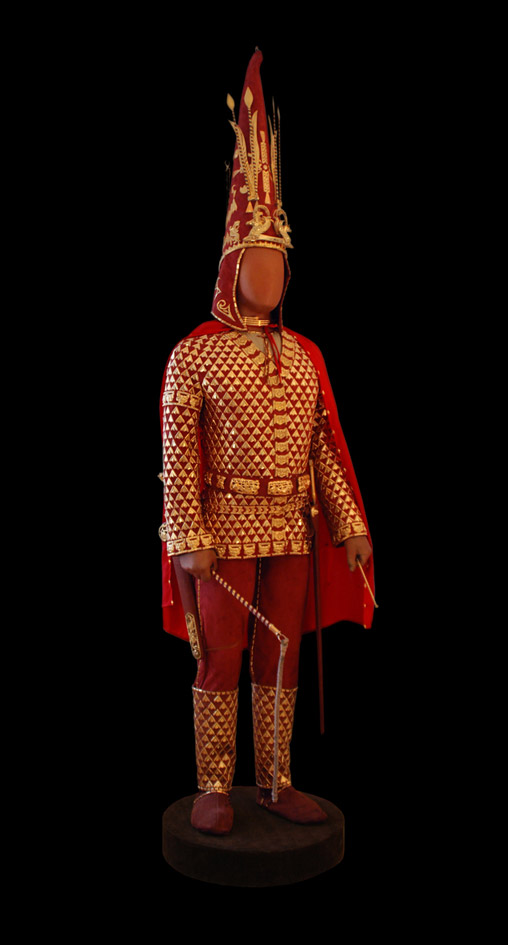Western Kazakhstani archaeologists have finally displayed the exclusive artifacts found in the ancient burial discovered in 2012, West Kazakhstan Oblast Center for History and Archaeology.
The ancient burial containing remains of a noble woman was discovered in Terekty district in Western Kazakhstan Oblast two years ago and was declared the oldest "golden" burial on the territory of Kazakhstan.
.jpg)
Taksay-1, Mound 6, Female burial
This is one of the burials in the "golden series", meaning a mound containing golden fragments along with a skeleton. One such mound, discovered in south-eastern Kazakhstan in 1969, had warrior's equipment and assorted funerary goods that included 4,000 golden fragments and was dubbed the Golden Man.

Krym Altynbekov's recreation of the Golden Man. Photo courtesy of Krym Altynbekov
The archeological find made 2 years ago in West Kazakhstan contained the skeleton of a noble woman in the burial mound called Taksay-1. Next to the body there were all sorts of gold and silver vessels, makeup kits, remnants of richly decorated headdress and many pieces of golden jewelry. A horse bridle and household items that were believed to be necessary in the afterlife were also found.
The noble woman was covered with a blanket embroidered with golden plaques and there were more than 500 different golden fragments, which earned the woman her name - the Golden Woman or the Golden Princess.
The artifact of particular importance was a wooden comb depicting a battle scene in the war of the Saks against the Persians.
Prominent scientists and research centers of Japan, Germany and Russia were attracted to the uniqueness of the burial and studied the findings along with their Kazakhstani colleagues.
The latest breakthrough in the work allowed Murat Sdykov, head of West Kazakhstan Oblast Center for History and Archaeology, to identify the age of the burial. “The results of laboratory studies showed that the burial dates back to 4-5 centuries BC,” Sdykov said. The age of the woman was hard to identify due to heavy decomposition of bones. Nevertheless, it is clear that the burial is characteristic of Zoroastrianism. In addition, Sdykov informed that two female guards were buried along with the Golden Princess.
“The richness of the burial speaks about the status of the buried woman. It points that there were few rich people in that period and that the society was already stratified. There are two other kurgans [mounds] next to Taksay, which we will excavate next year. It is noteworthy that this mound had not been damaged or looted,” Sdykov said.
The burial mound was made around a wooden structure that sagged a long time ago. At some point tomb robbers attempted to raid the burial but, fortunately, failed to reach the burial chamber itself.
Reconstruction of the garment was entrusted to the famous restorer Krym Altynbekov. Thanks to his work, one can now see what Golden Princess might have looked like 2500 years ago. Gold plaques of four types were sewn on the upper part of the garment: differently shaped geometric pieces depicted ram griffins, rams, griffins and swastikas. Scientists call them solar, implying worship of the sun characteristic for the nomads of the time, which is also supported by the "Avesta", the core collection of sacred Zoroastrianism texts.
.jpg)
Full garment reconstruction made by Krym Altynbekov. Photo courtesy of Krym Altynbekov
.jpg)
Headdress. Photo courtesy of Krym Altynbekov
.jpg)
The pommel of the headdress. Photo courtesy of Krym Altynbekov
.jpg)
.jpg)
Temple pendants. Photo courtesy of Krym Altynbekov
.jpg)
Oval shaped plaques depicting two opposing ram-griffins. Photo courtesy of Krym Altynbekov
.jpg)
Square shaped plaques depicting two opposing heads of rams. Photo courtesy of Krym Altynbekov
.jpg)
Swastika shaped plaques depicting four griffin heads arranged in a circular composition. Photo courtesy of Krym Altynbekov
.jpg)
The sleeves of the garment were adorned with wolf fangs in gold rim. Photo courtesy of Krym Altynbekov
.jpg)
Gold beads of biconical shape. Photo courtesy of Krym Altynbekov
.jpg)
.jpg)
.jpg)
Golden bracelets. Photo courtesy of Krym Altynbekov
.jpg)
Mirror. Photo courtesy of Krym Altynbekov
.jpg)
Bronze cauldron. Photo courtesy of Krym Altynbekov
.jpg)
Brazier. Photo courtesy of Krym Altynbekov
.jpg)
The unique Taksay comb. Photo courtesy of Krym Altynbekov
.jpg)
Comb. Reconstruction of the plot by Krym Altynbekov. Photo courtesy of Krym Altynbekov
Composition depicting a battle scene between two soldiers in a chariot and their enemy, a single foot soldier, is inscribed in the rectangular space in the center of the crest/comb. The depiction is a relief, a realistic one.
.jpg)
Reconstruction of the comb by Krym Altynbekov. Photo courtesy of Krym Altynbekov
Golden Woman is one of the most astonishing archeological findings of the recent years. It sheds some light on the wealth and power of the ancient Scythians [Saks]. The Saka were a group of nomadic warrior tribes of Iranian origin, who inhabited the steppes of modern-day Kazakhstan in 1 thousand BC to first centuries AD.
By Dinara Urazova


